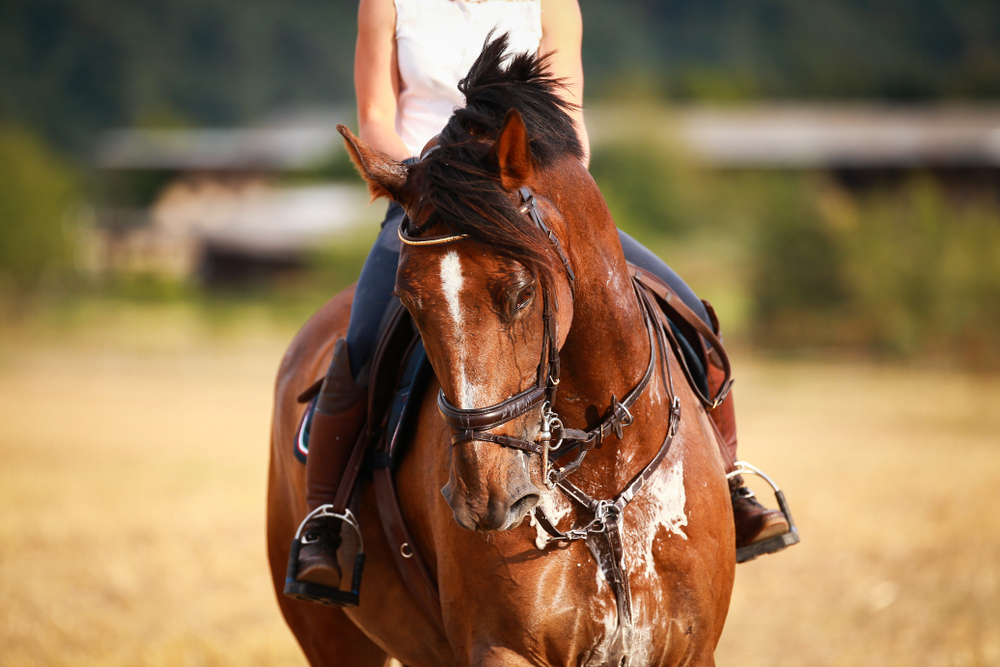Whinny’s Wisdoms

Hi everyone, Whinny here! Here in Florida, it’s been brutally hot lately! I heard my Springhill docs saying it’s even worse than a usual summer. It’s been hard on the horses too – we’ve had a bunch of horses in our area stop sweating, which the docs say is a pretty big problem. They actually want them to get gross and sweaty to stay healthy! There’s a fancy name for when they don’t sweat well enough – Anhidrosis.
Normal Sweating
It’s really important for a horse to sweat so it can keep his internal organs at a normal temperature even when he’s working hard or it’s hot outside. Horses have a lot of sweat glands in their skin, and many of them are a different type than the ones you humans have. Have you noticed that when your horse sweats, it’s often white and frothy looking? That’s because they have something called apocrine sweat glands that make sweat rich in proteins and lipids that causes them to look “lathered up”. Sweat also contains a lot of water and electrolytes like sodium, potassium, and chloride. As the water evaporates off your horse’s body, it cools him down, transferring the heat into the air. A horse’s normal body temperature is from 98.5 to 100.5 Fahrenheit. When he’s exercising, it may be elevated, but will return to normal quickly at rest.
What’s the Deal with Non-Sweaters?
When your horse has a decreased ability to sweat like he should in response to an increased body temperature, it’s called anhidrosis. Because sweating is the horse’s primary way of cooling himself, if he doesn’t sweat appropriately it can cause him to get overheated, not perform well, or even develop dangerous heat stroke. Horses lose 65-70% of body heat through their sweat, so if they’re unable to do that, it’s a pretty big deal. Anhidrosis can have a significant effect on your horse’s ability to be ridden and perform or even just function as a pasture pet.
During hot weather or hard exercise, a horse with anhidrosis won’t sweat as much as he should or might not sweat at all. He can have patchy sweat (like only under the saddle pad), a little sweat, or no sweat. He might appear to be working much harder than he should be or breathing heavily to try to cool off, even after he’s done working or just while standing around.

Anhidrosis is a problem mainly in hot and humid, tropical kind of places, like my dear home state of Florida and other states around it. This is especially a problem when the temperatures stay high for long periods of time, and don’t drop down much at night, like the perma-summer we seem to have here in Florida. Lucky us! It’s not as common in cooler, more temperate climates, but it can happen there too, especially in heat waves. Making matters worse, when the humidity is high, the sweat is even less able to evaporate into the already water-saturated air, so it decreases how effectively sweat can cool the horse.
It’s not known exactly why or how anhidrosis happens, but it’s thought that the sweat glands get over-stimulated and so they start to work less well. The onset can be sudden or more gradual. It can happen to horses that are born in a hot climate as well as horses that are new to it. So being from Florida doesn’t protect them, unfortunately. Between 2-6% of horses are estimated to have anhidrosis. No links to specific breeds, ages, colors, or sex have been identified – the risk is equal for all horses.
Chronic anhidrosis has been linked to atrophy (degeneration) of the sweat glands, leading to a permanent loss of the glands’ ability to produce sweat. Researchers are looking into associations with decreased excretion of chloride through the urinary system and in sweat glands, but this is still being investigated.
Recognizing and Diagnosing Anhidrosis
Because some horses with anhidrosis still sweat a bit, it can be tricky to recognize if your horse is affected. Some areas of the body can continue to sweat, but not enough to cool the horse sufficiently. For example, a horse with anhidrosis might continue to sweat under his mane or saddle pad. You may notice first that your horse doesn’t perform well in hot weather. He may take longer than normal to recover after exercise or breathe heavily even when standing in the shade. He may have a higher-than-normal pulse or temperature.
Here are some things to watch for:
- Lack of sweat, or a small amount of sweat, in situations when other horses are sweating a lot
- Coat is dry and clean to the touch
- Fast or labored breathing, especially when standing around not working
- Flared nostrils
- Low energy or fatigue
- Slow ability to cool down after exercise
- Increased body temperature (especially serious when it’s higher than 104)
- Seeking and remaining in the shade (especially if food is elsewhere)
- Sometimes, eating or drinking less than normal
- In chronic cases – dry, itchy or flaky skin. Sometimes there is hair loss.
My docs can often diagnose a horse based on their physical exam and the signs your horse is showing. If the diagnosis isn’t certain, there is a test they can do to check the amount of sweat your horse is able to produce. For this test, my doc injects a small amount of a medication called terbutaline into the horse’s skin to elicit sweating in that spot. That tests the amount of sweat your horse can produce compared to a normal horse.
Treatment
So if your horse is a non-sweater, what to do? Well sure, if you move your horse to a cooler climate where hot, humid weather is less likely, they will certainly be more comfortable. Many horses will start sweating again when they are in a cooler environment, and that is the only sure–fire approach. But, it may not be a realistic option for many people and horses.
One of the simplest things to try is an electrolyte supplement, which is a good idea in the summer even if your horse sweats normally. Several remedies that have been tried over the years, with variable success, including commercial supplements such as One AC or Platinum Refresh, and even dark beer such as Guinness. Most of them are fairly safe to try, though they may or may not work. At Springhill Equine, we often use a combination of acupuncture and Chinese herbal therapy and find that can be quite successful in some cases.

Here are some other ways to keep a non-sweater more comfortable:
- Keep him in a stall or shaded paddock during the day. A severely affected horse may not be able to tolerate turnout on hot days.
- Provide fans, misters, or a sprinkler. Some horses will cool off in a pond if they have access to one.
- Make sure he always has cool water to drink
- Keep work to a minimum during the hot times of the year and ride early in the morning
It’s better to prevent your horse from getting overheated than to have to treat him if he does, but if you get in a bind here are some steps to follow
- Move him somewhere shady
- Hose him down with a continuous flow of cool water or sponge him repeatedly with water from a bucket filled with water and ice
- Use portable fans
- Offer him cold water to drink
- Take his temperature, heart rate, and respiratory rate if you can
- Call my doc!
So if your horse is all stinky and sweaty after a ride, and you have to bathe him and wash your saddle pads yet again, don’t grumble about it, be happy about that sweat!
Until next week,
Whinny
P.S. Have you heard the exciting news? The Adventures of the Horse Doctor’s Husband 3 is available for pre-order! You can reserve your ebook today, and it will release on Sept. 8th! If you prefer a paperback or hardcover, they’ll be releasing on (or a bit before) Sept. 15th, just a week or so away! Click Here to go over to the book page on my website for links to purchase.

 Whinny’s Wisdoms is the official blog of Whinny the Clinic Mouse at Springhill Equine Veterinary Clinic in Newberry, Florida. If you liked this blog, please subscribe below, and share it with your friends on social media! For more information, please call us at (352) 472-1620, visit our website at SpringhillEquine.com, or follow us on Facebook!
Whinny’s Wisdoms is the official blog of Whinny the Clinic Mouse at Springhill Equine Veterinary Clinic in Newberry, Florida. If you liked this blog, please subscribe below, and share it with your friends on social media! For more information, please call us at (352) 472-1620, visit our website at SpringhillEquine.com, or follow us on Facebook!
[jetpack_subscription_form title="Subscribe to Whinny's Wisdoms"]

